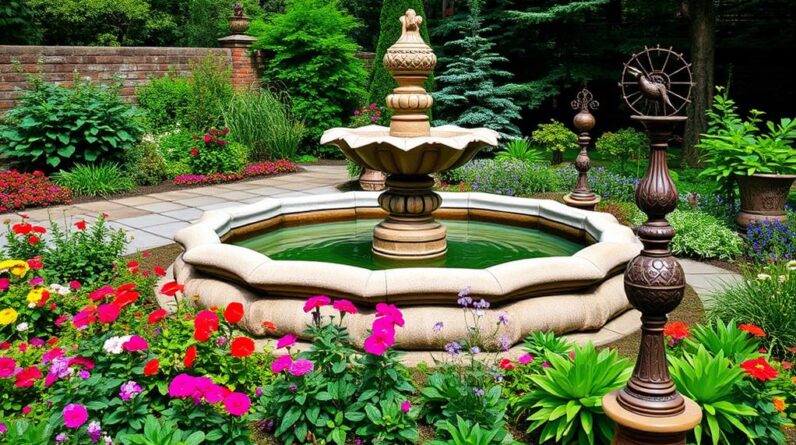
Imagine stepping into a lush oasis, surrounded by vibrant blooms and the soothing sounds of nature. In this article, we delve into the world of healing gardens and explore the profound therapeutic benefits they offer.
Discover how these enchanting spaces can enhance your physical and mental well-being, foster social connections, and create a sense of community. Join us as we uncover the art and science behind designing successful healing gardens, and explore inspiring case studies from around the globe.
Get ready to embark on a journey of innovation and transformation.
Key Takeaways
- Healing gardens provide a sanctuary to escape from everyday pressures and find solace in nature.
- Exposure to green spaces in healing gardens can reduce stress, lower blood pressure, and improve mental well-being.
- Engaging in gardening activities in healing gardens brings a sense of purpose and fulfillment, boosting mood and overall well-being.
- Healing gardens offer a sensory experience through the use of fragrant flowers, textured plants, and soothing sounds, which can help reduce stress and anxiety.
The Role of Nature in Healing
You can experience the healing power of nature through the serenity of a garden. In today's fast-paced and technology-driven world, finding moments of peace and tranquility can be challenging. But stepping into a garden allows you to reconnect with the natural world and rejuvenate your mind, body, and soul.
Surrounded by lush greenery, colorful flowers, and the gentle sound of flowing water, you can feel a sense of calm wash over you. The therapeutic benefits of nature are well-documented, with studies showing that exposure to green spaces can reduce stress, lower blood pressure, and improve mental well-being.
By immersing yourself in the beauty of a garden, you can tap into the healing energy of nature and find solace amidst the chaos of everyday life.
Now, let's explore the physical health benefits of healing gardens.
Physical Health Benefits of Healing Gardens
Stepping into a healing garden can promote physical well-being by stimulating your senses and encouraging movement. The vibrant colors of flowers and the soothing sounds of flowing water can immediately uplift your mood and reduce stress.
As you walk along the garden paths, the uneven terrain challenges your balance and strengthens your muscles. The fresh air and sunlight provide your body with essential vitamin D, boosting your immune system and improving bone health. The act of gardening itself is a physical activity that can improve your flexibility, strength, and dexterity.
Whether you're planting seeds, pulling weeds, or simply enjoying the beauty of nature, a healing garden offers a multitude of physical health benefits.
Transitioning into the next section, let's explore the mental health benefits of these therapeutic gardens.
Mental Health Benefits of Healing Gardens
Sometimes, but, spending time in a healing garden can have a positive impact on your mental health. Gardens have the power to soothe your mind, reduce stress, and promote relaxation.
The combination of natural elements, such as sunlight, fresh air, and greenery, can help alleviate symptoms of anxiety and depression. The serene and peaceful atmosphere of a healing garden provides a sanctuary where you can escape from the pressures of everyday life and find solace in nature.
Engaging in activities like gardening or simply sitting and observing the beauty around you can bring a sense of purpose and fulfillment, boosting your mood and overall well-being.
Additionally, the sensory experience of being in a healing garden, with the fragrant flowers, gentle sounds of nature, and the feel of the earth beneath your fingertips, can stimulate your senses and provide a therapeutic effect on your mental state.
Social Connections and Community in Healing Gardens
But, being in a healing garden can provide opportunities for you to form meaningful social connections and foster a sense of community. The serene and natural environment of a healing garden creates a conducive setting for interaction and collaboration. Whether you strike up a conversation with a fellow visitor or participate in group activities, these social connections can have a positive impact on your well-being. In a healing garden, you can find a diverse community where individuals come together to support and uplift each other. Here is a table that illustrates how healing gardens can facilitate social connections and community building:
| Benefits of Social Connections and Community in Healing Gardens | Examples |
|---|---|
| Increased sense of belonging and support | Group gardening sessions, community events |
| Opportunities for shared experiences and learning | Workshops, educational programs |
| Enhanced social skills and communication | Conversations with fellow visitors, volunteering |
Take advantage of the healing garden's potential to connect with others and create a vibrant community that nurtures personal growth and well-being.
Designing Healing Gardens: Elements and Considerations
When it comes to designing healing gardens, there are a few essential components you should consider.
Firstly, incorporating natural elements such as plants, water features, and stones can have a profound impact on the healing process. These elements can create a calming and serene environment that promotes relaxation, reduces stress, and enhances overall well-being.
Essential Garden Design Components
To create a healing garden, you should carefully consider the essential design components. These components won't only enhance the beauty of your garden but also contribute to its therapeutic benefits. Here are three important elements to include in your garden design:
- Variety of plants: Incorporate a diverse range of plants, including colorful flowers, aromatic herbs, and calming greenery. This variety will stimulate the senses and create a soothing environment.
- Accessibility and pathways: Ensure that your garden is accessible to all, with wide pathways that can accommodate wheelchairs or walkers. Smooth surfaces and handrails can provide stability and support for those with mobility challenges.
- Seating areas: Create comfortable seating areas where visitors can relax and enjoy the serenity of the garden. Provide options for both sun and shade, allowing individuals to choose their preferred spot.
By considering these design components, you can create a healing garden that promotes relaxation, rejuvenation, and overall well-being.
Now, let's explore the impact of natural elements on the therapeutic benefits of gardens.
Impact of Natural Elements
You will notice that incorporating natural elements into your healing garden, such as water features and native plants, can have a profound impact on its therapeutic benefits. These elements not only enhance the aesthetics of your garden but also create a harmonious environment that promotes healing and relaxation.
Water features, such as ponds or fountains, have a calming effect on the mind and help to drown out excess noise. The sound and movement of water can create a sense of tranquility and serenity, reducing stress and anxiety. Native plants, on the other hand, provide a connection to the local environment and have been found to improve air quality and promote biodiversity. They can also attract birds and butterflies, adding to the overall sensory experience of your garden.
Incorporating natural elements into your healing garden is a simple yet effective way to create a space that not only looks beautiful but also nourishes your mind, body, and soul. Consider the following table for inspiration on how to incorporate natural elements into your garden:
| Natural Element | Benefits |
|---|---|
| Water Features | Calming effect, reduces stress and anxiety |
| Native Plants | Improved air quality, biodiversity, sensory experience |
| Rocks and Stones | Grounding, stability |
| Trees and Shrubs | Shade, privacy, wildlife habitat |
Case Studies: Successful Healing Gardens Around the World
You'll be amazed by the success stories of healing gardens around the world. These inspiring case studies demonstrate the powerful therapeutic benefits that gardens can offer. Take a look at these incredible examples:
- Changi General Hospital, Singapore: This hospital's rooftop garden provides a serene space for patients to heal. Surrounded by lush greenery and calming water features, it promotes relaxation and reduces stress.
- Hortus Haren, Netherlands: This garden focuses on sensory stimulation, with fragrant flowers, textured plants, and soothing sounds. It has been shown to improve the well-being of individuals with dementia.
- Rusk Rehabilitation Hospital, United States: This innovative garden incorporates a variety of therapeutic elements, such as wheelchair-accessible paths, raised garden beds, and calming outdoor seating areas. It has significantly enhanced the rehabilitation process for patients.
Frequently Asked Questions
Are There Any Specific Plants or Flowers That Are More Beneficial for Healing in a Garden?
There are certain plants and flowers that can be more beneficial for healing in a garden. These include lavender, chamomile, and rosemary, which have calming and soothing properties that promote relaxation and reduce stress.
How Do Healing Gardens Cater to Individuals With Physical Disabilities?
Healing gardens cater to individuals with physical disabilities by providing accessible pathways, raised garden beds, and adaptive tools. These features allow for easier navigation and participation, promoting physical well-being and a sense of empowerment.
Can Healing Gardens Help Alleviate Symptoms of Chronic Pain or Illnesses?
Healing gardens have been shown to alleviate symptoms of chronic pain or illnesses. The natural environment promotes relaxation and reduces stress, which can help manage pain and improve overall well-being.
Are There Any Specific Design Principles That Are Considered Essential in Creating a Healing Garden?
To create a healing garden, prioritize these essential design principles: sensory stimulation, natural elements, accessibility, privacy, and flexibility. Consider how each element can promote relaxation, reduce stress, and improve well-being. Get creative and innovate!
Do Healing Gardens Have a Positive Impact on Children and Their Development?
Healing gardens can have a positive impact on children and their development. They provide a nurturing and calming environment that promotes physical and mental well-being, creativity, and social interaction.












